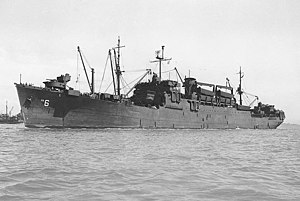 USS Heywood (APA-6), lead ship of the Heywood class
| |
| Class overview | |
|---|---|
| Name | Heywood class |
| Builders | Alameda Works Shipyard |
| Operators | |
| Preceded by | McCawley class |
| Succeeded by | Harry Lee class |
| Built | 1919 |
| In service | Commercial: 1920-1940 |
| In commission | Navy: 1940-1946 |
| Completed | 5 (acquired) |
| Lost | 1 |
| Retired | 4 |
| General characteristics | |
| Class and type | Heywood-class attack transport |
| Displacement | 8,000 tons (lt) 14,450 t.(fl) |
| Length | 507 ft (155 m) |
| Beam | 56 ft (17 m) |
| Draft | 25 ft 6 in (7.77 m) |
| Propulsion | 1 × De Laval geared turbine drive, 4 × Babcock & Wilcox header-type boilers, 1 propeller, designed shaft horsepower 9,500 |
| Speed | 16-17 knots |
| Capacity |
|
| Complement | 43-50 officers, 337-524 enlisted |
| Armament | (1945): 4 × 3"/50 cal dual-purpose guns, 4 × 40mm gun mounts, 8-16 × single 20mm gun mounts.. |
The Heywood-class attack transport was a class of US Navy attack transport built in 1918-19. Four were ordered for British use but requisitioned by the United States Shipping Board (USSB) for WW I service when the U.S. entered that war. All saw commercial service under the USSB and commercial lines until acquired by the Navy in 1940 and converted, some to transports, and eventually all into attack transports for World War II service.
Like all attack transports, the purpose of the Heywood class ships was to transport troops and their equipment to hostile shores in order to execute amphibious invasions. To fulfill their mission, attack transports were fitted with a substantial number of integral landing craft, and were well armed with antiaircraft weaponry to protect themselves and their vulnerable cargo of troops from air attack in the battle zone.